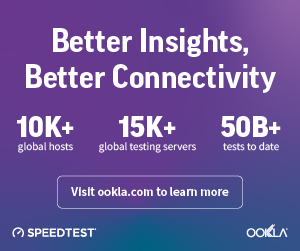
As telecom providers look to build out fiber networks to deliver services into unserved and underserved communities, one component that must be closely evaluated is the middle mile and its ecosystem.
Often referred to as an internet highway for broadband, middle mile infrastructure does not connect directly to an end-user location. However, it does aggregate and transport large quantities of data traffic over long distances to the last mile, the end point, a home or building.

High-speed broadband-driven services can provide rural areas with distance learning, advanced telehealth, entertainment, increased business profitability and economic development opportunities that bridge the digital divide and not only sustain communities but allow for future growth and prosperity.
Over the last five to seven years, who owns that middle mile has been increasingly important when it comes to fiber-to-the-home and fiber-to-the-X services. Thus, providers should carefully weigh and evaluate options: Is it better to build out the middle mile infrastructure or purchase it from another carrier?
What to consider when building the middle mile
Is build out economically viable? The middle mile is more difficult to build and time sensitive in terms of construction completion to turn up services. A combination of engineering and design criteria must be taken into account, as well as potential additional uses and the TAM (total addressable market) along those routes. For example: If there is a route to build that’s of interest to a customer, it is important to determine if that route creates an alternative diverse route or completes a ring in the overall network design. Does that route pass by an additional number of businesses and another number of homes as well as another community where services can be offered? All of these considerations determine the economic viability of a potential middle mile project.
Maintenance impacts network performance. The fiber, connectivity and electronics must be robust enough to handle transport requirements. Thus, the network must be continually upgraded to meet growing demands. This rule pertains to all aspects of the network including support technology to increase bandwidth for moving large amounts of data, dense wavelength-division multiplexing, wave services or a direct 400 Gigabit connection.
The fiber, electronics and connectivity must be not only robust enough to support increasing traffic, it must also be agnostic for successful transport by a variety of providers and users. With changing technologies and needs, the network must support multiple use case scenarios to be viable long-term.
Keep in mind that some legacy networks are 30 to 40 years old and not equal to what has been deployed in the past five years, so age of network is key. OPEX associated with continually working on and improving the system must also be considered. However, the quality of the middle mile wins out every time.
Funding options and implementation. Whether it’s the ranch 10 miles outside of town or a small community of 40 or 50 homes, it’s difficult to make a business case to extend that middle mile without government funding. As providers reach further into rural communities, it becomes less economically viable to solely invest their own capital and obtain a return. Government funding, whether federal or state, is becoming more critical. However, funding is not a blank check. There are scoring parameters such as experience, cost structures, pricing, and speed of service, that are among qualifying considerations for providers.

It’s also imperative that if a provider uses regulatory dollars, they can deliver in the specified timelines at the speeds they promise. If a company is not successful, it is a failure to deliver to those customers in need and it can (and should) reflect negatively when it comes to applying for future government funding.
Local knowledge. Understanding permit requirements of the community, e-municipality, pole owner, right of way owner and timetables is important when planning a build. In addition to permitting, the costs associated with engineering requirements and being able to get in and construct are considerations that are often underestimated.
Build or buy a middle mile network?
Whether it’s carrying today’s extremely high bandwidth requirements, deploying multi-gig and beyond traffic from hyperscalers and continued diligence, it’s not just the electronics. The physical assets of the middle mile network are key. Companies that provide the middle mile services must be prepared to continue investing to upgrade and maintain that infrastructure. After all, the owner of the middle mile network is ultimately responsible for the customer experience.
There are definite benefits to leasing the middle mile to free up capital. Utilizing existing infrastructure to speed deployment and reduce upfront costs are attractive alternatives. However, the key to success is finding partners who understand that a superior customer experience is vital.
Those who build the middle mile network not only control the quality of the initial build and all of the components that go into a successful and high-quality build, but also control the outage response, speed to repair and long-term maintenance of the asset. Each one of these components are key pieces to defining the overall customer experience.
Once again, when it comes to buying or building the middle mile infrastructure, providers should keep in mind the ultimate goal: the quality of the middle mile results in the quality of the customer’s experience and can differentiate their company in a consistently increasing competitive environment.
Joe Pellegrini is President and Chief Operating Officer of Great Plains Communications. This Expert Opinion is exclusive to Broadband Breakfast.
Broadband Breakfast accepts commentary from informed observers of the broadband scene. Please send pieces to commentary@breakfast.media. The views expressed in Expert Opinion pieces do not necessarily reflect the views of Broadband Breakfast and Breakfast Media LLC.


